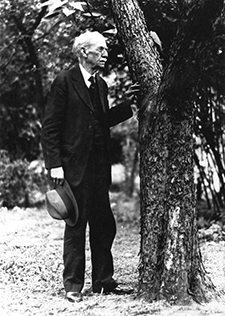History

The development of a permanent insect collection was realized early in the history of Purdue University. In 1879, the Zoological Museum contained as many as 14 cases of insect specimens collected from Indiana and the Scheuch Collection containing approximately 7,000 specimens and more than 200 species, mostly beetles, from Europe. These early collections were probably used in teaching but have been lost and no trace of them remains.
Frank Troop, Purdue’s first entomologist, arranged for the purchase of the T.B. Ashton collection of beetles in 1896. This marked the beginning of the present entomological collection. The Ashton collection, mainly from New York and Kansas, was the only permanent collection in the department until after 1920 when Professor J.J. Davis became department head.
During Davis’s tenure, Willis S. Blatchley deposited the vast majority of his collections, including his types. The Blatchley collection, comprised primarily of Hemiptera, Orthoptera, and Coleoptera, is one of the most important historical components of the PERC.
When John V. Osmun became department head in 1959, he immediately began the development of a biosystematics research program. This included the organization and maintenance of the Purdue Entomological Collection, with Leland Chandler as the first curator of insects. While Chandler was museum curator, the department purchased the Titus Collection. In addition, through his personal research and that of his students, the collection of bees became one of the largest and most significant in the country. He remained curator until 1966 when he was named Assistant Department Head.
Ross Arnett served as curator from 1966 to 1970 and was succeeded in 1971 by a new director for the museum, W. Patrick McCafferty and full-time curator Arwin V. Provonsha. From its origins, the research collection was housed on the second floor of what became Entomology Hall (now Pfendler Hall). However, due to weight concerns, it was moved to the south wing of the basement.
During the construction of Whistler Hall in 1981, a water main broke in the middle of the night flooding the basement of Entomology Hall to a depth of 18–24 inches. The collection sustained considerable damage from which it took years to recover. In 1998, the department moved from Entomology Hall to Smith Hall. To accommodate the continued expansion of the collections, a mobile storage system was installed.
Major Contributions to the PERC
T.B. Ashton Collection. This collection has some historical value, particularly because it was the first major collection added to the PERC. However, the specimen data labels give the state only, and thus, are of limited use.
W. S. Blatchley Collection. Until recently, Blatchley’s material constituted the largest single component of the PERC. His specimens remain extremely valuable and the PERC contains the vast majority of his types. They make up the bulk of our pinned type collection.
J.J. Davis Aphid Slide Collection. The PERC houses a substantial number of his slide-mounted aphids, including several types. Unfortunately, over time they have deteriorated greatly. Some years ago, the slides were examined by an expert slide restorer, but it was determined that nothing that could be done to improve them.
Leland Chandler Collection. At one time, the Chandler collection of bees was one of the largest and most significant in the country. In addition, for many years under Chandler’s leadership, the department ran a research station at Hovey Lake in Posey County. Collecting at that site added considerably to the collection in many orders.
Norville Downie Coleoptera Collection and Identifications. Downie was a statistician in the Psychology Department at Purdue. He was also one of the best beetle taxonomists in the eastern United States. During the 1970s and 1980s, he donated thousands of beetle specimens to the PERC and identified much of our backlog of unidentified specimens. His name can be found on ID labels throughout the PERC’s Coleoptera holdings.
George F. Edmunds Ephemeroptera Collection. Edmunds was on the faculty at the University of Utah. He was the major professor of both Pat McCafferty and Arwin Provonsha and was also, at the time, the worlds leading authority on mayflies. During his career, he collected extensively throughout most regions of the world. Prior to his death in the early 1990s, he deposited most of his collection of over 120,000 specimens in the PERC. As a result, along with the collections of McCafferty, Provonsha and other smaller donated collections, the PERC holds the world’s largest and most comprehensive collection of Ephemeroptera.
R. Tom Everly Carabidae Collection. During the 1950s and 1960s, Everly made extensive collections of ground beetles in both Indiana and Ohio. His material is housed in the PERC.
Robert W. Meyers Diptera Collection. Bob Meyers was a member of the entomology extension staff during the 1960s and 70s. He collected extensively throughout the state and specialized in Diptera, primarily Dolichopodidae. Prior to his arrival at Purdue, Bob was a missionary in Nigeria where he also collected extensively. All of his material was deposited in the PERC.
E.B. Montgomery Odonata Collection. “Monty” was a member of the entomology faculty at Purdue for many years, specializing on Odonata. By the time he retired in 1970, he had amassed a sizable and significant collection. When he retired, he donated his entire collection to the USNM, though much of it rightfully belonged to Purdue. The mater was settled by officially donating it to the Smithsonian as the “Purdue-Montgomery Collection.” The USNM then returned a substantial number of specimens to Purdue, including most of the Indiana collected material.
Frank Young Aquatic Coleoptera Collection. Young was a faculty member at Indiana University who specialized in aquatic Coleoptera. When he retired in the early 1980s, he divided his collection between several institutions, including Purdue. Most of his Indiana material as well as specimens from elsewhere throughout North America are deposited in the PERC.
James E. Wappes Coleoptera Collection. Purdue alumnus and founder of the American Museum of Coleoptera (San Antonio, TX), Jim has generously donated tens of thousands of Neotropical Coleoptera, especially longhorned beetles (Cerambycidae).
